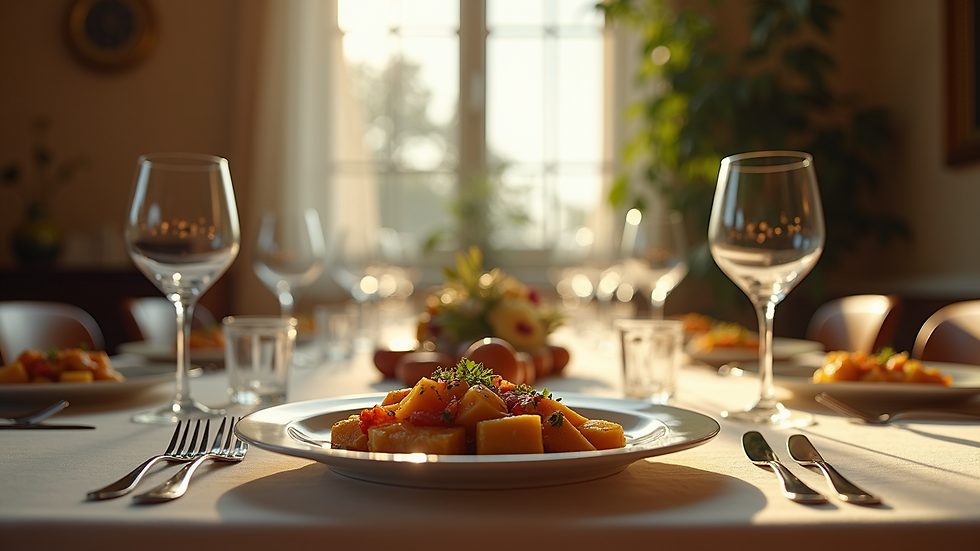5 Ways Food Photography Tricks Your Brain Into Feeling Hungry (And How You Can Play Along!)
- studiofoodography
- Mar 11
- 4 min read
Food is an essential part of our daily lives, but have you ever noticed how certain images of food can make you feel an overwhelming craving? It's not just the delicious treat on your plate; it's the way it's presented. The psychology of food photography plays a significant role in how we perceive food and how it influences our hunger levels. Grab a drink, settle in, and let's explore five powerful tricks that food photography uses to ignite your appetite!
1. Color Psychology: The Vivid Palette
One of the first things you'll notice in any food photograph is the color. Colors can evoke emotions and set the mood, making your stomach growl just by looking at them. Bright and vibrant hues like reds, greens, and yellows can make food appear more appetizing and fresh. For instance, the rich red of ripe tomatoes or the lush green of fresh herbs can create visual intrigue and stimulate your cravings.

Food photographers often select colors that complement one another to enhance appeal. When you see an image of a well-staged meal bursting with colors, your brain may begin to associate those hues with flavors, triggering feelings of hunger. Embrace this color psychology in your own food photos, and you may find your meals looking more delicious than ever!
2. Composition: The Art of Arrangement
The way food is arranged in an image is crucial. Rogue sprigs of parsley, a drizzle of sauce, or strategically placed ingredients can create anticipation. Known as the "rule of thirds," a well-composed photograph draws your eye toward the food, enhancing your experience and making the dish desirable.
When composing your shots, consider how different elements interact within the frame. Placing the main dish off-center creates a focus point while allowing the background to play a supporting role. Play around with layers and textures; adding depth can make meals seem more enticing.

Remember, something as simple as a thoughtfully arranged plate can make all the difference. By using composition to your advantage, you’ll make simple meals look extraordinary!
3. Lighting: Natural is Best
Lighting plays a pivotal role in food photography. Soft, diffused natural light often makes food look more appealing and realistic, as harsh shadows can diminish the vibrancy and textures of your meal. The golden hour—when the sun is low in the sky—provides particularly flattering lighting for food photos.
When you're preparing to take your shots, scout out spots in your home where the light can dance beautifully on your dishes. Experiment during different times of the day to find that magical glow.
Good lighting not only makes food look more mouth-watering but also gives it a three-dimensional feel, enhancing flavors in your mind before you even take a bite.
4. Context: Setting the Scene
The environment surrounding the food can significantly impact your hunger levels. Adding props like rustic cutlery, colorful tablecloths, or even a backdrop of a kitchen can elevate your dish's story. Context adds to the overall experience, making it more relatable and inviting—an essential element when captivating your audience.
When creating your own food photos, think of the narrative. Instead of just focusing on the dish, consider how to integrate its setting naturally. Does a chocolate cake belong in a cozy kitchen or a classy café? The accuracy of that environment can trigger warm, nostalgic feelings or a culinary adventure in your mind.

Good storytelling through context makes your meal not just food, but an experience that you want to be part of, which can amplify that craving factor immensely!
5. Texture: The Wow Factor
Texture is a significant player in making your mouth water. Taking close-up shots that showcase the surface of the food can highlight juiciness, crispiness, or creaminess, drawing you in to taste it. Think gooey cheese pulling away from a slice of pizza, or a drizzle of honey glistening atop pancakes.
When photographing your meals, zoom in to showcase those inviting details. Capturing the golden-brown crust of a freshly baked pie or the smooth glide of chocolate ganache enhances visual appeal and triggers sensory memories that make you feel hungry.
Incorporating texture can fool the brain into believing it's seen a tantalizing dish. It activates those taste buds even before you take a bite.
Conclusion
Understanding how food photography influences your brain isn’t just fascinating—it is a toolkit for anyone looking to make their meals look irresistible. By embracing the principles of color psychology, composition, lighting, context, and texture, you can elevate your own food photography skills.
Whether it’s for your blog, a personal project, or just capturing everyday meals, remember that the way you present your dish can directly impact how hungry others (and you!) might feel. So get creative, keep experimenting, and watch as your food photos spark the appetite of anyone who lays eyes on them!
With these tips in your back pocket, you’re ready to play along and create images that don’t just showcase food but evoke cravings, making everyone want to dig in! Happy shooting!



Comments